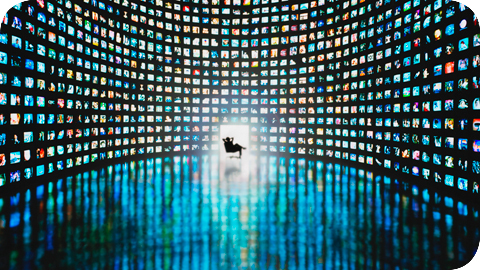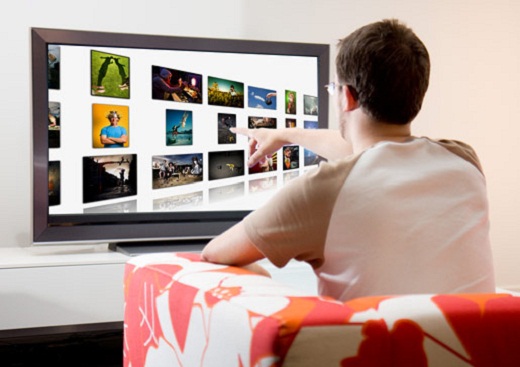This is the third article in a three part series discussing key trends in TV. The first article looked at how new interface technologies are enabling new ways to control our TVs. The second article focused on the multi-screen TV experience. This article focuses on how interactive TV trends are driving the need for improvements in TV image quality.
Full HD is not enough for Future TV
Some might believe our latest flat panel televisions represent the zenith of picture quality. This is not surprising given we often hear that 1080P resolution or “Full HD” are “future proof” technologies. The oft-cited reasoning is that for a given screen size, viewed from a normal watching distance, the acuity of the eye cannot discern resolutions beyond Full HD. Another reason why Full HD is considered future proof is because actually a very small percentage of video content is even broadcast at this resolution. Most digital pay TV broadcasting systems transmit in lower resolution formats – the industry is still catching up.
Certainly, for those looking to buy their next TV set – no one should be concerned that 1080P is not good enough. Considering the horizon of time people buy and keep a TV set which is about 8 years– a consumer cannot go wrong with “Full HD”. But for people interested in where the industry is going in the long term –looking out over the next ten years, our image quality is going to see massive improvements making today’s TV technology look primitive.
Part of the reason why we can expect big improvements in TV video quality has to do with our superior eyesight. Our capacity to see is many multiple orders of magnitude greater than what our TVs can display. For example, a Full HD TV displays about 2 million pixels of video information. In real life, one of our eyes processes about 250 million pixels – but since we have two eyes channeling vision to our brains – our effective vision makes use of greater than 500 million pixels of video information. And while it is true that we can only discern a limited resolution from a given distance – our eyesight is also sensitive to contrast, color saturation, color accuracy and especially movement. All these areas are where TV systems can improve.
Detractors may argue TVs do not have to be perfect – just a reasonable representation. Others may argue that consumers only care about TV size and price that TV quality is not a selling point. But I argue TV image quality does matter – quality has always had to keep pace with the growing size of TV screens. TVs will continue to get larger – requiring improvements in resolution as our room sizes will start to limit viewing distance. Also, the nature of interactive TV and future 3D systems will make us want to sit closer to the TV set – again mandating video quality improvements.
Interactive TV’s Make You Sit Closer
Interactive TVs will bring games, virtual worlds and new video applications drawing us physically closer to the TV screen. Gaming is a huge industry- with almost $50B spent on gaming consoles, software and accessories. Virtual world games are increasingly popular. “World of Warcraft” is a massively multiplayer online role-playing game with over 10 million subscribers. All kinds of social virtual worlds such as the Sims, Second Life, IMVU and Club Penguin are attracting millions of players. IMVU, with over 50 million registered users, is a social game where people can develop personal avatars and spend time in virtual worlds chatting and interacting. While many of these games are still played on PCs – migration to the living room TV is inevitable. Console games have already shown the way – the size and immersive nature of the large screen TV will draw others into the living room as well.
3D display will also drive the need for improving display resolution and image quality. Sure, everyone hates 3D glasses – but technology will continue to evolve and glassless 3D displays will continue to improve and come down in price. There will be applications that consumers will demand in 3D such as sports – people will see the advantages of watching close up sports games on the large screen display in vivid, artifact free video.
OEMs and broadcast equipment companies are investing heavily in supplying the infrastructure to make this happen. 3D advertising will take on more importance – imagine having the option to tour a car or a house in extremely vivid 3D. On the entertainment side, movie and video directors will become much better at using 3D perspectives in such a way to take advantage of image quality improvement. Today 3D effects are more like a gimmick – watch the arrow fly into the room for example. But going forward directors will make more subtle use of 3D adeptly drawing viewers into to the film or the show. On a beautiful large screen display with ultra high resolution and image quality, viewers will practically feel like they are part of a movie or scene.
3D also opens up a world that we could only dream about when matched with the power of the internet. For example, the evolutions of virtual worlds and their capabilities becomes much more compelling with large screen displays. A simple example is virtual tourism and world exploration. Just as Google has taken a picture of all the street views of the world, there is no reason we cannot build a 3D model of the whole terrestrial experience on earth in a few years. Imagine then the capability to walk around the world as a virtual tourist and view the world from the comfort of your 3D television.
As virtual worlds improve and evolve, new immersive ways to interact with large screen TVs will continue to evolve. Many social activities come to mind as well as the concept of participating or viewing in e-sports. E-sports are virtual sports games that can also be viewed by others. The prospects for e-sports are boundless and limited only by imagination. Virtual bullfights, gladiator battles, racing events will be watched on-line the same way we watch football games today.
The display-use model will also change over time. Today our concept of a display is a TV set that sits in the living room – a piece of functional furniture. With the advent of new display materials like OLED, display will transform from furniture to architectural material. In fact there is no reason why the wall in your den cannot become a display. In fact, why stop with the wall? Imagine the immersive feeling of the ceiling, floor, and walls all around built of display – it’s the video equivalent of surround sound. In fact, the architectural use of display could add interesting use cases beyond entertainment.
For example, inlaid architectural materials can appear in almost in any room around the house. Touch screen uses in the kitchen, can provide not only control but also interactive recipe applications and videos on cooking instructions. Bathroom walls can provide wallpaper backgrounds or any kind of networked information that we already see on our PCs. Inlaid display technologies will appear on appliances as well as anywhere people need information or help with controls. The point of all this is that again there will be many reasons in the future of us needed to get close to the screen – and all this near proximity will demand increases in display quality.
TV Development Underway
Already major TV OEMs are working on the next step up in resolution over Full HD. There are multiple propositions in development for higher order resolution TV systems. TV OEMS are already demonstrating “4KX2K” systems that provide 4096 X 2160 pixel arrays. Even beyond “4KX2K” is Ultra High Definition (UHD) which provides 7,680X4320 pixels resolution which equals 33 million pixels or about 16 times the number of pixels used by Full HD systems. UHD was first introduced by Japan’s national TV broadcaster NHK in 2003. NHK, marketing the resolution as “Super Hi-Vision” had to build the cameras and display technology from scratch to be able to create a UHD demonstration system. Since then NHK has displayed the system at numerous broadcasting shows. Toshiba, LG and Panasonic showed UHD systems at CES 2011 – likely more UHD sets will be shown in 2012. UK’s BBC also is interested in this format. The BBC announced plans to provide UHD coverage of the 2012 London games.
In addition to higher resolution, OEMs continue to invest in superior display technologies like organic light emitting diode (OLED) displays. OLEDs have several advantages over LCD and plasma display technologies. For example, OLED do not make use of a backlight and emit light directly. Direct emission results in a much more vivid display of color, contrast and viewing angle over LCDs. Since there is no backplane in OLED TVs, OLEDS are a much more power efficient and lower in weight. OLED displays are also flexible – opening up new opportunities to use displays in various new applications in architectural display and even clothing.
OLEDs also have a very high response time over LCD. In fact, the relative low response time of LCD, required the industry to introduce all kinds of approaches to compensate by introducing frame rate conversion techniques. OLEDs response time increases response time by a factor of 1000 over LCD allowing for a much better display motion performance.
Improvements will also need to continue on the broadcast side. Higher resolution TVs consume bits at an alarming rate. For example, uncompressed ultra high HD would demand 24Gbps a major jump over ~1.5Gbps required for Full HD. Any increases in resolution will demand major improvements in data compression as well as networking, storage and broadcasting capacity.
But the march of improvements will continue. As TV screens get larger and the way we use these screens draw us in closer – the need for improved image quality will also continue to improve.
Our TV experience will change dramatically over the next ten years. As these series of articles have discussed the whole TV experience will continue to morph the way we spend our time watching large screen displays. 2012 will bring some interesting signs about how all this will play out. 2012 we will see OEMs developing much better ways to interact with TVs – our ability to control the TV through new remote technologies and improvements in finding and sharing content will make major advances. We can expect more use of our hand held tablets and smart phone devices joining us in front of our TV sets. Interactive TV will bring, not only more sources of content, but also new tools to help recommend as well as share content and media that we really want to see. Finally, the way we use TV will be much more immersive demanding major improvements in the video quality in TVs over what we have today.



